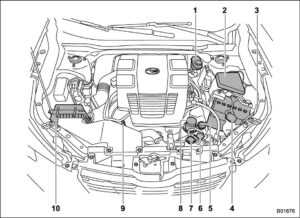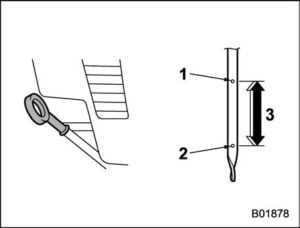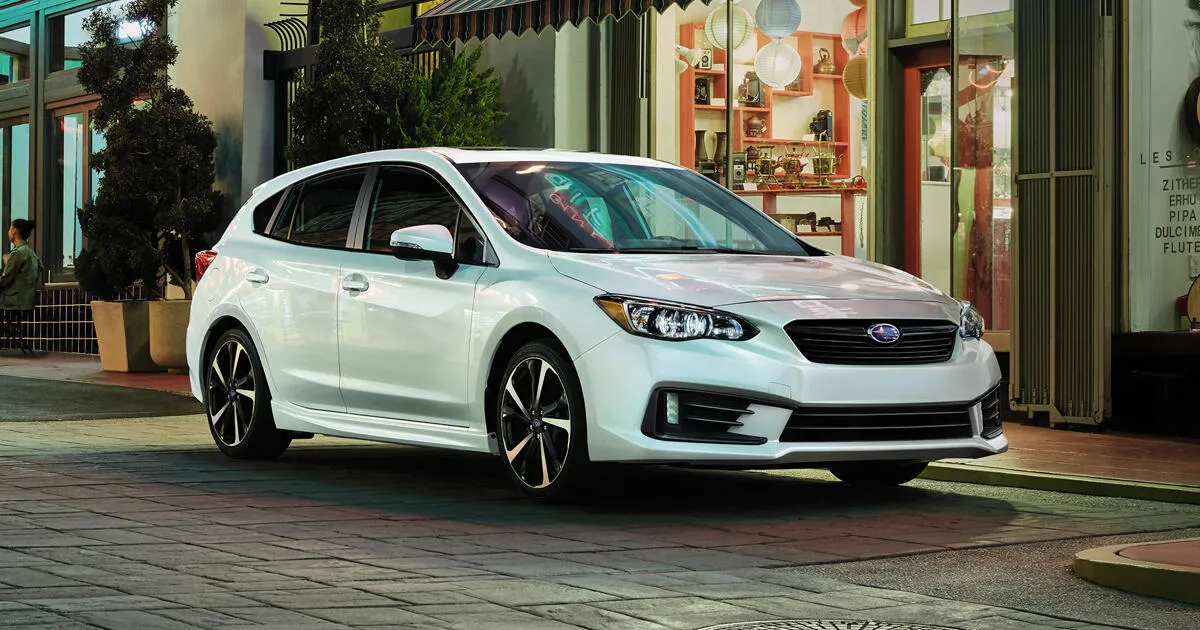Subaru Impreza 2023 Engine Hood Base Sedan
The 2023 Subaru Impreza Base Sedan has a solid 2.0-litre Subaru Boxer four-cylinder engine hidden under the hood. The engine is known for its horizontal layout, which lowers the center of gravity and makes the car easier to handle. This engine, which makes about 152 horsepower, works with Subaru’s usual Symmetrical All-Wheel Drive system to make the car more stable and improve its grip on different types of roads. The design of the hood is both practical and aesthetically pleasing, fitting in with Subaru’s modern style. It makes upkeep and checks easy to do. It also has safety features like a crumple zone, which is part of Subaru’s dedication to keeping people inside and on the streets safe. As a result, the 2023 Impreza’s engine hood is not just a cover; it’s an important part of the car’s design and function.
2023 Subaru Forester Specs, Price, Features, Mileage (Brochure)
Engine hood
CAUTION
- Be extremely careful not to catch fingers or other objects when closing the engine hood.
- Do not push the hood forcibly to close it. It could deform the metal.
- Be extremely careful opening the engine hood when the wind is strong. The engine hood could close suddenly, possibly causing injuries from slamming.
- Do not install accessories other than genuine SUBARU parts to the engine hood. If the engine hood becomes too heavy, the stay may not be able to support holding it open.
- Check that the end of the hood stay is inserted into the slot. If it is not inserted properly, the hood may drop and cause injury
To open the hood:
- If the wiper blades are lifted off the windshield, return them to their original position.

- Pull the hood release knob under the instrument panel.

- Release the secondary hood release by moving the lever between the front grille and the hood toward the left.

- Lift up the hood, release the hood prop from its retainer and put the end of the hood prop into the slot in the hood. Hold the grip for handling the hood prop.
To close the hood:
- Lift the hood slightly and remove the hood prop from the slot in the hood and return the prop to its retainer.
- Lower the hood to a height of approximately 7.8 to 11.8 in (20 to 30 cm) above its closed position and then let it drop.
- After closing the hood, be sure the hood is securely locked.
If this does not close the hood, release it from a slightly higher position.
WARNING
Always check that the hood is properly locked before you start driving. If it is not, it might fly open while the vehicle is moving and block your view, which may cause an accident and serious bodily injury.
Engine compartment overview
- Brake fluid reservoir/Clutch fluid reservoir (MT models)
- The fuse box
- Battery
- Windshield washer tank
- Radiator cap
- Engine oil filler cap
- Engine coolant reservoir
- The engine oil filter
- Engine oil level gauge
- Air cleaner case
Engine oil
- If the level gauge cannot be pulled out easily, twist the level gauge right and left, then gently pull it out. Otherwise, you may be injured accidentally straining yourself.
- Use only engine oil with the recommended grade and viscosity.
- Be careful not to spill engine oil when adding it. If oil touches the exhaust pipe, it may cause a bad smell, smoke, and/or a fire. If engine oil gets on the exhaust pipe, be sure to wipe it off.
Engine oil consumption
Some engine oil will be consumed while driving. The rate of consumption can be affected by such factors as transmission type, driving style, terrain, and temperature. Under the following conditions, oil consumption can be increased and may require refilling between maintenance intervals.
- When the engine is new and within the break-in period.
- When the engine oil is of lower quality.
- When the incorrect oil viscosity is used.
- When engine braking is employed (repeatedly).
- When the engine is operated at high engine speeds (for extended periods of time).
- When the engine is operated under heavy loads (for extended periods of time).
- When towing a trailer
- When the engine idles for extended periods of time.
- When the vehicle is operated in stop-and-go and/or heavy traffic situations.
- When the vehicle is used under severe thermal conditions.
- When the vehicle accelerates and decelerates frequently.
Under these or similar conditions, you should check your oil at least every 2nd fuel fill-up and change your engine oil more frequently. Different drivers in the same car may experience different results. If your oil consumption rate is greater than expected, contact your authorized SUBARU dealer who may perform a test under controlled conditions.
Locations of the oil level gauge, oil filler cap, and oil filter

- Oil level gaug
- Oil filler cap
- Oil filter
Checking the oil level
- Park the vehicle on a level surface and turn the ignition switch to the “LOCK”/ “OFF” position. If you check the oil level just after turning the ignition switch to the “LOCK”/“OFF” position, wait for at least 5 minutes for the oil to drain back into the oil pan before checking the level.
CAUTION
If the level gauge cannot be pulled out easily, twist the level gauge right and left, then gently pull it out. Otherwise, you may be injured accidentally straining yourself. - Pull out the level gauge, wipe it clean, and insert it again.
- Be sure the level gauge is correctly inserted until it stops.

- Full level
- Low level
- Approximately 1.1 US qt (1.0 liters, 0.9 Imp qt) from low level to full level
- Pull out the oil level gauge again.
- Check the oil levels on both sides of the level gauge. The engine oil level must be judged by the lowest of the two levels. If the oil level is below the low-level mark, add oil so that the full level is reached.
CAUTION
- Be careful not to touch the engine oil filter when removing the oil filler cap. Doing so may result in a burn, a pinched finger, or may cause some other injury.
- Use only engine oil with the recommended grade and viscosity.
- Be careful not to spill engine oil when adding it. If oil touches the exhaust pipe, it may cause a bad smell, smoke, and/or a fire. If engine oil gets on the exhaust pipe, be sure to wipe it off.
To add engine oil, remove the engine oil filler cap and slowly pour engine oil through the filler neck. After pouring oil into the engine, you must use the level gauge to confirm that the oil level is correct.
NOTE
- To prevent overfilling the engine oil, do not add any additional oil above the upper level when the engine is cold.
- After adding or changing the engine oil, warm up the engine and stop it on a level surface, then start the engine after a lapse of 1 minute or more. Confirm that the warning light has turned off after the engine has started.
Changing the oil and oil filter
Change the oil and oil filter according to the maintenance schedule in the “Warranty and Maintenance Booklet”. The engine oil and oil filter must be changed more frequently than listed in the maintenance schedule when driving on dusty roads, when short trips are frequently made, or when driving in extremely cold weather.
NOTE
- Changing the engine oil and oil filter should be performed by a well-trained expert. Contact your SUBARU dealer for changing the engine oil and oil filter. Fully trained mechanics are on standby at a SUBARU dealer to utilize the special tools, spare parts and recommended oil for this work, and also, Change the oil and oil filter according to the maintenance schedule in the “Warranty and Maintenance Booklet”.
The engine oil and oil filter must be changed more frequently than listed in the maintenance schedule when driving on dusty roads, when short trips are frequently made, or when driving in extremely cold weather.
NOTE - Changing the engine oil and oil filter should be performed by a well-trained expert. Contact your SUBARU dealer to change the engine oil and oil filter. Fully trained mechanics are on standby at a SUBARU dealer to utilize the special tools, spare parts and recommended oil for this work, and also, self, observe the local regulations and dispose of waste oil properly.
Recommended grade and viscosity
Use only engine oil with the recommended grade and viscosity.
NOTE
Engine oil viscosity (thickness) affects fuel economy. Oils of lower viscosity provide better fuel economy. However, in hot weather, oil of higher viscosity is required to properly lubricate the engine.
Synthetic oil
You should use synthetic engine oil that meets the same requirements given for conventional engine oil. When using synthetic oil, you must use oil of the same classification, viscosity and grade shown in this Owner’s Manual. Also, you must follow the oil and filter change intervals shown in the “Warranty and Maintenance Booklet”.
NOTE
Synthetic oil of the grade and viscosity noted in Chapter 12 is the recommended engine oil for optimum engine performance. Conventional oil may be used if synthetic oil is unavailable.
FAQ
It’s equipped with a 2.0-liter four-cylinder Subaru Boxer engine.
The engine delivers approximately 152 horsepower.
No, the base model’s engine is naturally aspirated, not turbocharged.
It comes with a choice of a five-speed manual transmission or a continuously variable transmission (CVT).
Yes, Subaru’s Symmetrical All-Wheel Drive is standard across all Impreza models.
The Impreza offers good fuel efficiency, varying slightly between manual and CVT models.
The hood release is located inside the cabin; pull it to release the hood latch.
Yes, after releasing the hood from the inside, a safety catch under the hood must be released to fully open it.
It typically features a manual prop rod to hold the hood open.
Regular checks should include engine oil, coolant levels, brake fluid, and battery condition.
Yes, it has an engine under cover for protection and improved aerodynamics.
Modifications can be made, but it’s important to comply with safety regulations and warranty terms.
The hood is typically made from steel, offering a balance of durability and weight.
There were no widespread issues reported specifically related to the engine hood.
To open the hood of a Subaru Impreza, locate the hood release lever inside the vehicle, usually near the driver’s footwell. Pull the lever to release the hood, then lift the hood using the exterior release lever or latch located at the front of the vehicle.
Useful Link
View Full User Guide: Subaru Impreza 2023 Base Sedan User Guide
Download Manuals: https://www.subaru.com/owners/vehicle-resources/manuals.html
2024 Subaru Impreza Specs, Price, Features, Mileage (Brochure)


